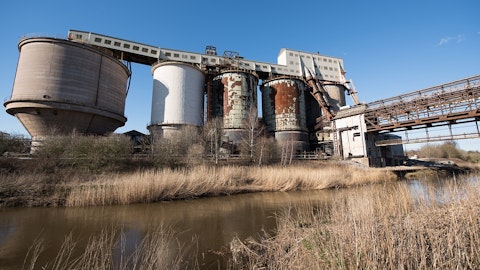Operator: [Operator Instructions]. Our next question is from the line of Josh Spector with UBS. Please go ahead.
Josh Spector: So, I’m definitely reading here that you don’t want to be specific on 2Q. But I do want to walk through some of the moving parts, I guess, because, obviously, first quarter had the cogen impacts that you specifically called out. Europe gas was higher last year, but it was flat through the quarter. Oil was lower last year. It’s higher now. So, I’m looking at trying to think about the energy side of things. Oil is probably a little bit of a positive. That gas, I mean, as it relates to specialty, is probably a little bit of a negative. I guess, is there anything we should be looking at outside of volume growth that should be drivers there? And I guess, I’ll ask again specifically if 2Q EBITDA could be higher year-over-year.
And I’m focusing that there because, obviously, the second half of last year, the comps are easy. I mean, I would hope you’re going to be higher year-over-year. 2Q is probably more informative of the run rate for us, which is why my focus is there. So, any additional color would be helpful.
Jeff Glajch: Let me give you a little more clarity on Q2 last year just to get us all in the same starting place. So our EBITDA last year in Q2 was $87 million included in that was about $4 million of onetime items, which I think we discussed in the call last year as well as we had some cogen benefit, because of some forward sales of power that we had set up in late ’22 that benefited all of ’23 that across the year is probably about $10 million, so you can kind of think about that as $2.5 million a quarter. So, between that $2.5 and $4 the operating result last year would have been right around $80 million. So, I just want to get us kind of balanced in the same place there.
Corning Painter: So, do we expect to exceed that number? Yes, we do. Do we necessarily think we’re going to blow past $87 million? Well, we certainly aspire to, but there’s that element. There’s the forward power sale that we’ve talked about before, but just to remind us that’s in last year’s numbers.
Josh Spector: So, I guess, I mean, if I look at the earnings per ton and assume that some of that’s baked in, we think specialty normalizes year-on-year, maybe slightly better than the first quarter. Rubber, you have some benefit. I guess the other piece of that comes down to volumes. I think Jon asked about it before a little bit, but I mean, year-on-year, there’s a easy comp that should be up 10% ish. Is that a fair way to think about it?
Corning Painter: Well, I would say if we take the pieces, I would expect specialty GP per ton to continue to improve from where we are today. I would expect the rubber GP per ton to more or less hold where we are just because the majority of the contracts are locked in at this point. And so, yes, volume growth from there as the year progresses on a modest level is sort of what takes us into higher levels. Jeff anything you want to add?
Jeff Glajch: No. I think you did well. We will continue to see weakness in volume in the Americas we believe. But again, that’s built into the GP per ton number that we gave you.
Josh Spector: And I do want to ask one beyond focusing on 2Q. On the La Porte project, I mean, it’s good to see the groundbreaking. I guess when I look at that startup within a year of groundbreaking seems pretty good. So, I guess there’s two questions with that is. One, the level of comfort or maybe buffer baked into that timeline for us to be actually running and commissioning, call it, 12 months or less from now? And then two, how do you see that rent plan ramping up, and what does that mean for profitability over ’25, ’26? Do we have muted profitability because there’s startup costs and other things in ’25 or do we actually start to see that in the second half?
Corning Painter: I was wondering if we’re going to get that about groundbreaking and then commissioning just a little bit more than a year later. The majority of this plant is being built offshore in super modules. It’s I think a leading manufacturing technique. It derisks a lot of the cost inflation that you see in the U.S. Gulf Coast and labor availability. We are right on the Houston Shipping Canal. So, this site is a great opportunity to use those techniques. And that’s really where the how the bulk of the plant is going to come in. And that’s all on schedule. So, I think we feel really very good for that. Those modules will be coming in late this year. So, we do expect to be in startup, let’s say, mid next year, that kind of thing.
Now I do not expect any financial contribution in 2025 from La Porte at this point. I think that a qualification process is going to take some time. And the higher the differentiated product, the higher the margin you’re striking to achieve, the longer that it takes. And I would say well into 2026 I really wouldn’t expect a big contribution.
Josh Spector: Thank you, very much.
Operator: Ladies and gentlemen, as there are no further questions, I now hand the conference over to Corning Painter for his closing comments.
Corning Painter: Well, thank you all again for your time today. As an investor myself, I’d just like to thank you all for the trust that you put into us. And thank you for again for listening and for the thoughtful questions that we received as well. Please reach out if you have any further questions. We’d really be happy to hear from many of our investors. Thank you all and have a good rest of your day.
Operator: Thank you. The conference of Orion S.A. has now concluded. Thank you for your participation. You may now disconnect your lines.
Follow Orion S.a. (NYSE:OEC)
Follow Orion S.a. (NYSE:OEC)
Receive real-time insider trading and news alerts



